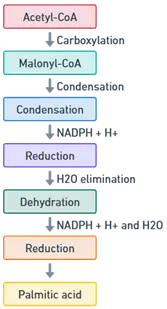- De novo synthesis of fatty acids refers to the process by which fatty acids are synthesized from simpler precursors, such as acetyl-CoA and malonyl-CoA. Palmitic acid (C16:0) is the primary product of this synthesis in humans.
- The process of mainly occurs in the cytosol of hepatocytes (liver cells) and adipocytes (fat cells).
Formation of Malonyl-CoA:
- Process: Acetyl-CoA, derived primarily from glucose metabolism, is converted into malonyl-CoA.
- Enzyme: Acetyl-CoA carboxylase (ACC).
- Mechanism: ACC adds a carboxyl group to acetyl-CoA using bicarbonate as a source, requiring ATP.
- Regulation: Acetyl-CoA carboxylase is the rate-limiting enzyme in fatty acid synthesis and is regulated by allosteric effectors and hormones.
Activation of Acetyl-CoA and Malonyl-CoA:
- Multi-Enzyme Complex: Fatty acid synthesis is catalyzed by a multi-enzyme complex called fatty acid synthase (FAS).
- Components of FAS: Includes acyl carrier protein (ACP) and acyltransferases.
- Transfer to ACP: Acetyl-CoA and malonyl-CoA are transferred to the ACP by acetyltransferase and malonyltransferase, respectively. Acetyl-CoA is attached to the cysteine residue of FAS, while malonyl-CoA is attached to the ACP’s phosphopantetheine prosthetic group.
Elongation of the Fatty Acid Chain:
- The elongation occurs through a series of condensation, reduction, dehydration, and reduction reactions, repeated until the desired chain length is achieved.
- For palmitic acid, the process is repeated seven times.
- Steps in Elongation:
-
Condensation of De novo synthesis:
- Process: The acetyl group on FAS condenses with the malonyl group on ACP, forming a four-carbon molecule (β-ketoacyl-ACP) and releasing one molecule of CO2.
- Enzyme: β-Ketoacyl-ACP synthase (KS).
-
Reduction of De novo synthesis:
- Process: The β-ketoacyl-ACP is reduced, converting the keto group to a hydroxyl group, forming β-hydroxyacyl-ACP.
- Enzyme: β-Ketoacyl-ACP reductase (KR), which uses NADPH as an electron donor.
-
Dehydration:
- Process: The β-hydroxyacyl-ACP is dehydrated to form a trans-2-enoyl-ACP.
- Enzyme: β-Hydroxyacyl-ACP dehydratase (DH).
-
Reduction:
- Process: The double bond in the trans-2-enoyl-ACP is reduced to form an acyl-ACP molecule with two additional carbons.
- Enzyme: Enoyl-ACP reductase (ER), which uses NADPH as an electron donor.
- Repetition: The cycle is repeated until the fatty acid chain reaches 16 carbons in length (palmitoyl-ACP).
Release of Palmitic Acid:
- Process: Once palmitoyl-ACP has been formed, the thioester bond between palmitic acid and ACP is cleaved.
- Enzyme:
- Product: Free palmitic acid is released.
-
Regulation of De Novo Fatty Acid Synthesis
-


